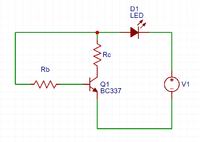Mhm ... Well, now I looked again at the construction of the npn transistor. The n layers are separated by a p layer, so electrically there is no direct connection (junction) between the collector and the emitter.
As for the thread. So graph 4 assumes that the transistor is saturated and a larger current Ic cannot flow? I've always understood the saturation state more or less in this way: the base current is so large that the collector current can no longer increase, the transistor is not able to pass beta-times higher current. If so...
Let's assume that we have some simplest arrangement, so completely pointless, as long as there is some basis for discussion.

Let it be like this:
Usup=12V - supply voltage
Rb - resistor regulating the base current
Rc - resistor for the LED (the question is whether it is needed?)
Rc gives it so that there will be a voltage drop across it, unnecessary voltage. Suppose this is 12V, and on the diode let's assume Uled=2V. The voltage drop across Rc should be 10V. I just don't know if it would work without it too? We're assuming we're using this BC337 and the note I linked.
We want the collector current Ic to be 20mA. In addition, the Ube voltage drop is assumed to be 0.7V (I don't see it in the note). I guess that's all.
First we calculate Rb. In Fig.3 we have a gain graph. For Ic=20mA, the gain is about 180. So Ib=20mA/180=111uA. Let be Ib=0.1mA.
Now from Ohm's law:
Ub=12V-0.7V=11.3V
Rb=Ub/Ib=11.3V/0.1mA=113k?
Now we calculate Rc. Exactly. The voltage drop across Rc should be 10V. What about the drop between collector and emitter? Because there will be some?
Without the drop, Uce (or Vce) would be:
Rc=Uc/Ic=10V/20mA=500?
Well cool. First of all, what about Uce?
The second thing - what is with the graph you mentioned. This Fig.4. Because I don't think I'm satiated here, right? Collector current 20mA, and according to the note, the maximum is 800mA.



